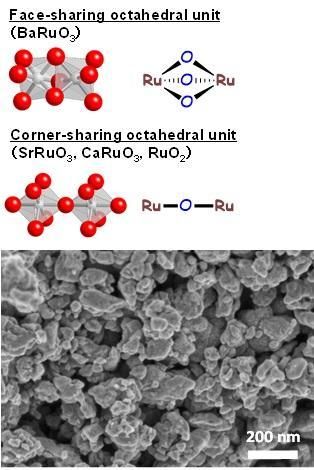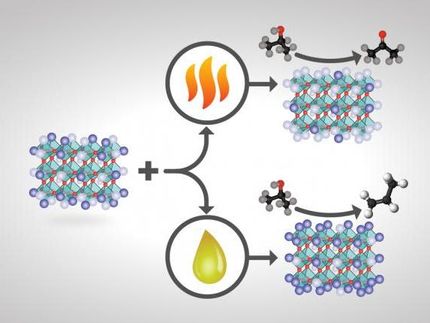Oxidation of sulfides with perovskite catalyst
Barium ruthenate promises easy handling and high yields
Advertisement
Researchers at Tokyo Institute of Technology have developed a ruthenium-based perovskite catalyst that shows strong activity even at low temperatures (down to 313 K). The reusable catalyst does not require additives, meaning that it can prevent the formation of toxic by-products. The Oxidation of sulfides is a commercially important process with broad applications ranging from chemicals production to environmental management.

Top: Schematic representations of the face-sharing unit in rhombohedral BaRuO3 and corner-sharing unit in tetragonal RuO2, cubic SrRuO3, and orthorhombic CaRuO3. Bottom: Scanning electron microscope (SEM) image of BaRuO3.
Keigo Kamata
A research group led by Keigo Kamata and Michikazu Hara of Tokyo Institute of Technology (Tokyo Tech) has succeeded in developing a barium ruthenate (BaRuO3) perovskite -- the first catalyst of its kind shown to be capable of the selective oxidation of sulfides under mild conditions, with molecular oxygen (O2) as the only oxidant and without the need for additives.
Firstly, it exhibits high performance even at 313 K, a temperature much lower than the 373-423 K range reported in previous systems including other ruthenium- and manganese-based catalysts. Secondly, its high rate of oxygen transfer indicates that it has many potential uses; for example, it is applicable to the oxidative desulfurization of dibenzothiophene, which can produce a 99% yield of pure sulfone. Thirdly, the new catalyst is recyclable -- the present study showed that BaRuO 3 could be reused at least three times without loss of performance.
The achievement overcomes several classic limitations, such as the need for additives, toxic reagents and high reaction temperatures to achieve good catalytic performance.
The catalyst has a rhombohedral structure (see Figure 1). While other ruthenium-based catalysts investigated to date such as SrRuO3 , CaRuO3 and RuO2 can all be described as having corner-sharing octahedral units, BaRuO 3 has face-sharing octahedra. This configuration is thought to be one of the main reasons behind the catalyst's higher oxygen transfer capability.
The way in which BaRuO3 was synthesized -- based on the sol-gel method using malic acid -- was also important. The researchers say: "The catalytic activity and specific surface area of BaRuO3 synthesized by the malic acid-aided method were higher than those of BaRuO3 synthesized by the polymerized complex method."
The study highlights the importance of subtle changes in the nanoscale structure of perovskite catalysts, and could provide promising leads for further research on a wide range of perovskite-based functional materials.
































































